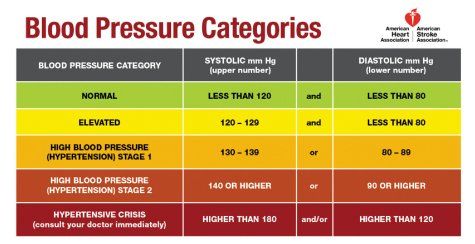Cracking the Blood Pressure Code
What it all means for you
Cracking the Blood Pressure Code – What It All Means
Checking your blood pressure is a routine measure to help monitor your health. Understanding what it means can be tricky. Let’s take a deeper look into what those numbers mean and what you can do to help yours improve.
Once your blood pressure is taken, you are read two numbers. The top number is the systolic, and the bottom number is the diastolic. This helps the practitioner determine if you are in a normal and healthy range, or if medication is indicated. Here is what those numbers mean:
Systolic pressure
is the pressure
generated by each heartbeat. This occurs during the contraction of the heart muscle.
Diastolic blood pressure
is the pressure between the heartbeats when the heart is resting.
Below is a chart from the American Heart Association. Where do you fall?
What increases my blood pressure?
· Exercise - The muscles require more oxygen, and with the increase in heart rate and pumping action as result, the blood pressure is raised.
· Diet - THIS IS UNDER YOUR DIRECT CONTROL
· Anxiety – Can raise the blood pressure through the effects of the “fight or flight” response.
· Pain - Can also raise pressure dramatically.
· Stimulants - Alcohol, nicotine, and caffeine intake can cause transient elevations of blood pressure.
Ways to Lower Blood Pressure Aside From Medication (which may still be necessary)
· Lose weight!
In general, you may reduce your blood pressure by about 1 millimeter of mercury (mm Hg) with each kilogram (about 2.2 pounds) of weight you lose.
· Exercise Regular physical activity (150 minutes a week, or about 30 minutes most days of the week) can lower your blood pressure by about 5 to 8 mm Hg if you have high blood pressure.
· DIET - Strategies
o Dietary Approaches to Stop Hypertension (DASH) by reducing sodium:
-
Read food labels
-
Eat fewer processed foods
- Don't add salt .
Just 1 level teaspoon of salt has 2,300 mg of sodium. Use herbs or spices to add flavor to your food.
- Avoid :
Deli meats, frozen pizza, pickles, canned soups and tomato products
o Adjust eating patterns
- Have 2 servings of fruit or vegetables with each meal
- Eat less meat with smaller portions or even eliminating meat occasionally
- Halve the fats – butter, margarine or dressings
· Quit Smoking
· Cut back on caffeine

ADDRESS
FAMILY MEDICAL CENTER1020 4th AveLake Odessa, MI 48849
website designed by SPECK DESIGNS
FAMILY MEDICAL CENTER
website designed by





